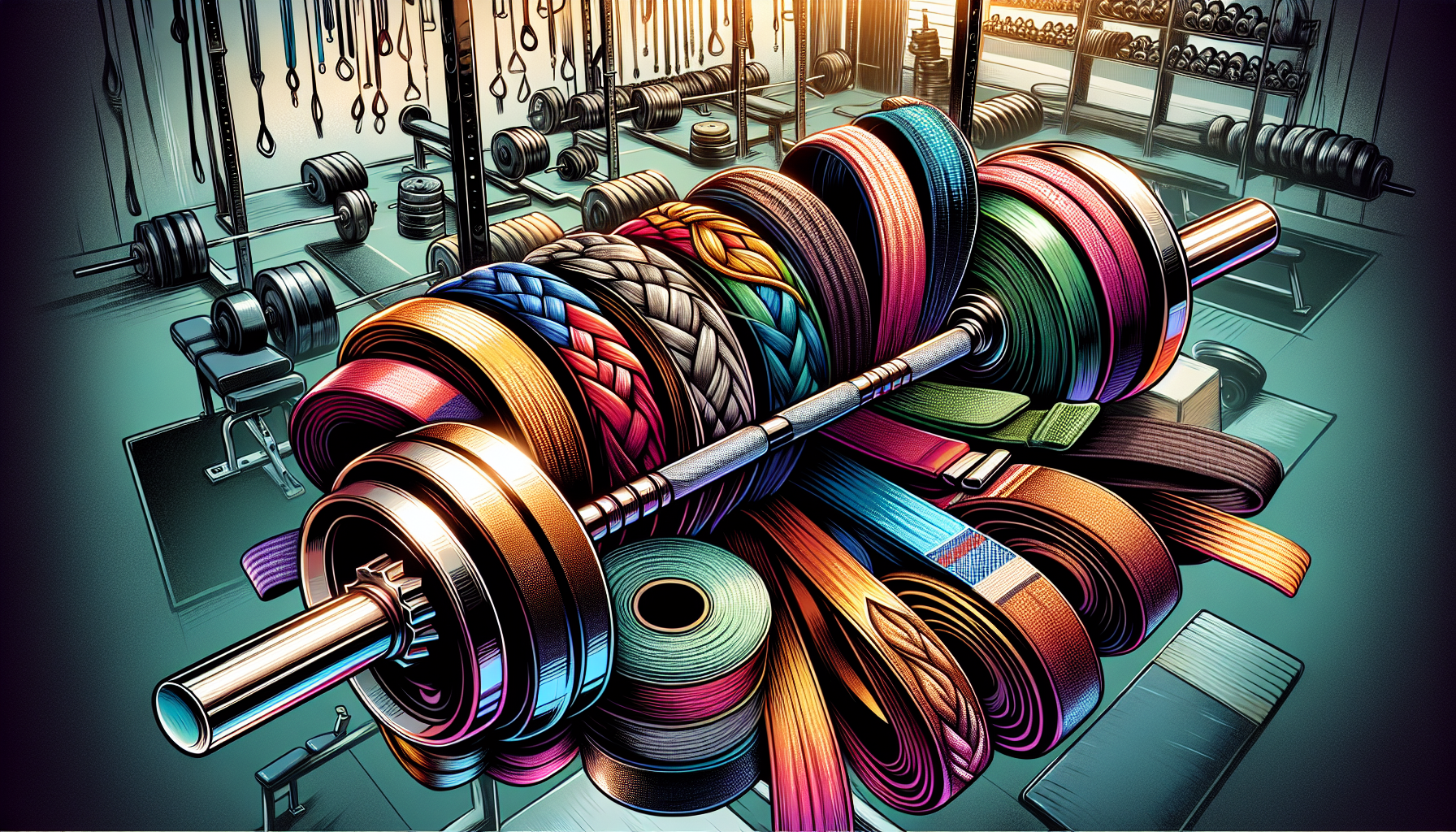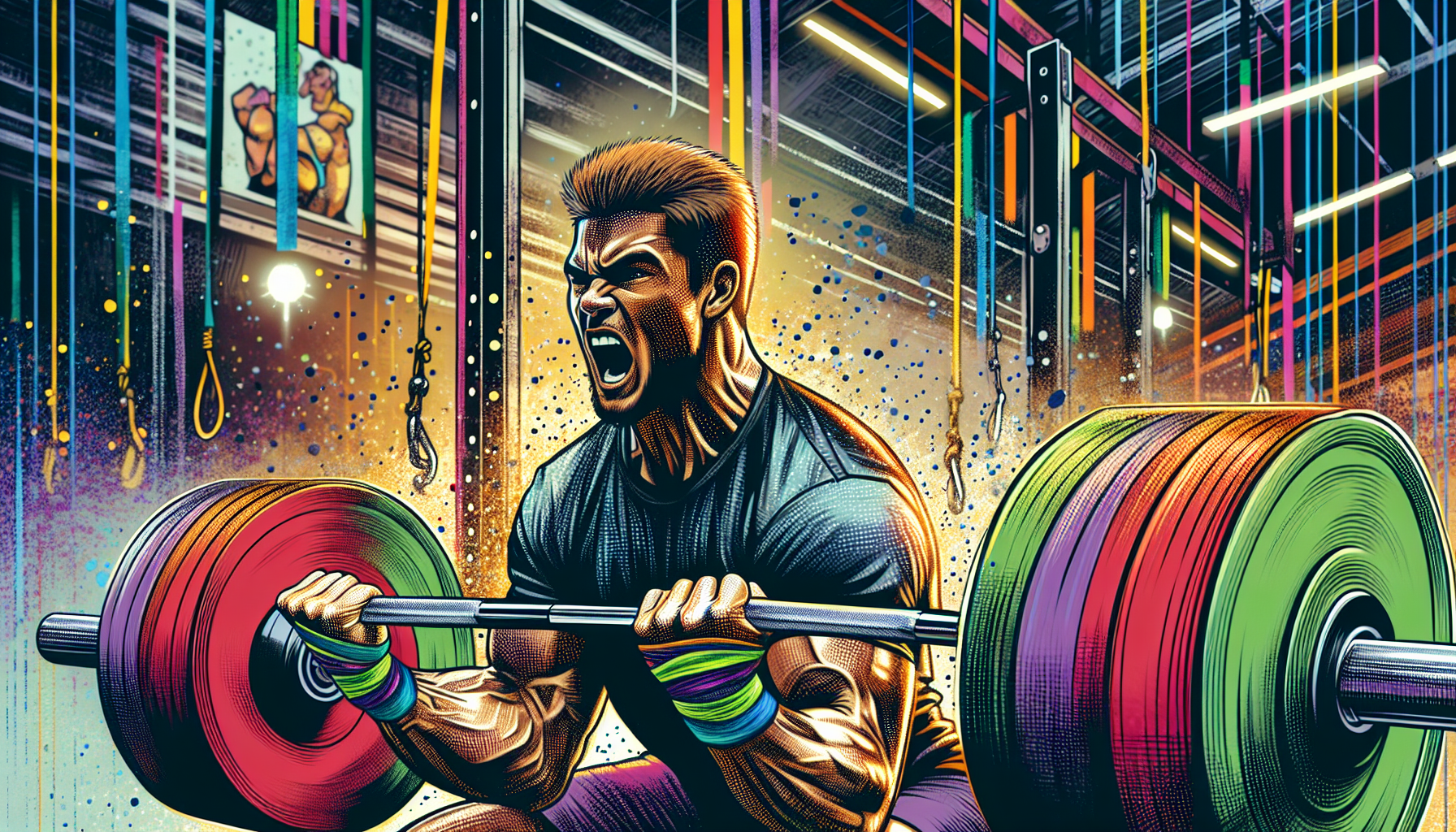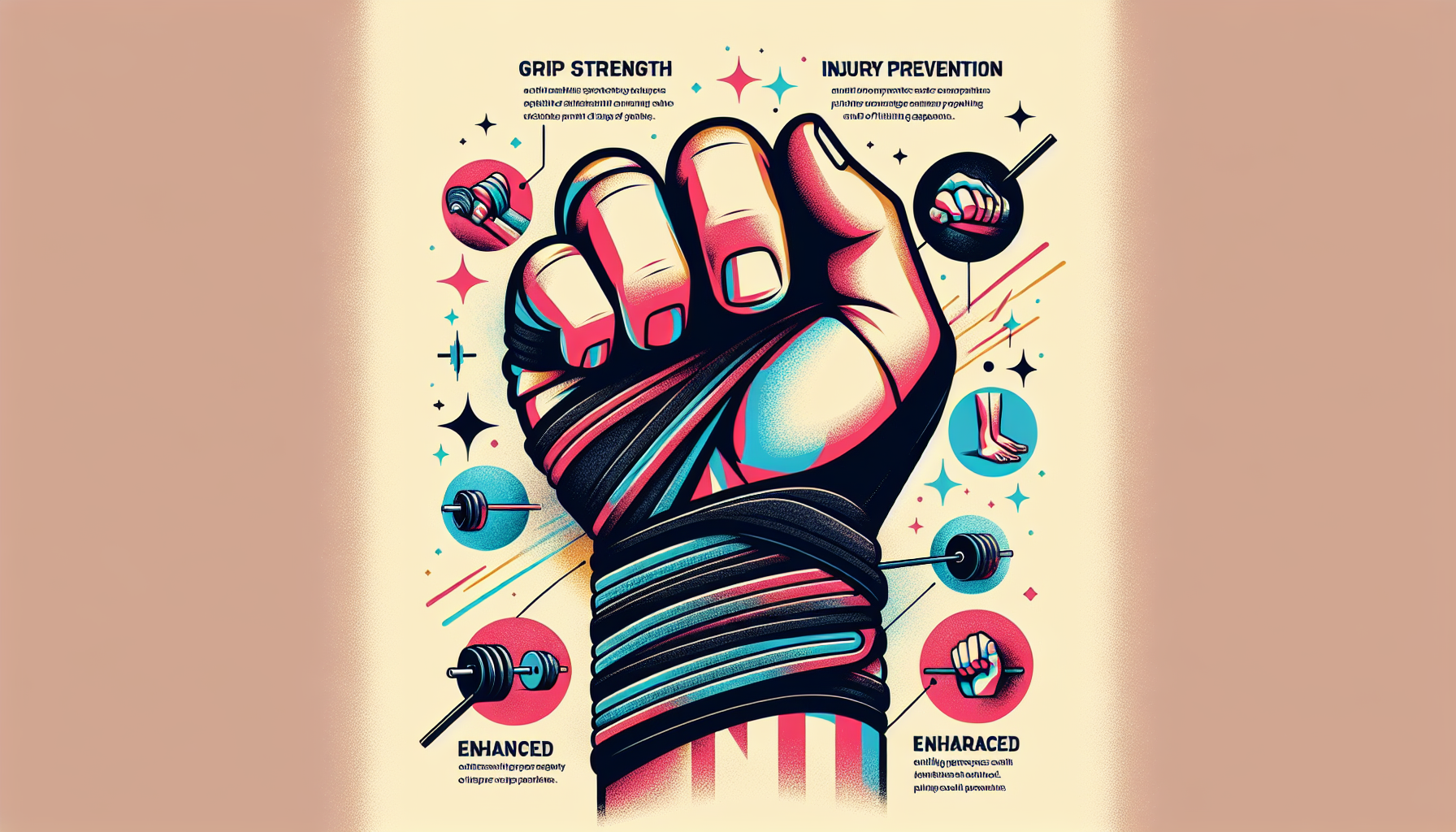Do wrist wraps help boost your grip strength when weightlifting? This article delves into how wrist wraps work, their benefits, and whether wrist wraps can boost your grip strength in weightlifting during lifts.
Key Takeaways
- Wrist wraps provide wrist stability and support during weightlifting, reducing the risk of injuries and improving lifting form.
- While they enhance comfort and grip stability, scientific evidence shows that wrist wraps do not significantly increase maximum grip strength.
- Choosing the right wrist wraps involves considering material, fit, and adjustability to ensure optimal support and performance during lifts.
Understanding Wrist Wraps

Wrist wraps are supportive devices worn around the wrists during weightlifting to enhance stability and reduce injury risk. Designed for comfort, they use breathable fabrics and adjustable straps that allow for a snug yet comfortable fit. These versatile tools can be used for various lifts, including bench presses, deadlifts, and shoulder presses, making them a staple in many lifters’ toolkits.
Wrist wraps are vital in weightlifting to ensure wrist stability and avoid injuries. They secure the grip and support the wrist joint, aiding lifters in maintaining proper form and reducing overextension risks.
Understanding wrist wraps and their functionality is key to appreciating their benefits.
What Are Wrist Wraps?
Wrist wraps are essentially bands of fabric that provide a secure and comfortable grip during weightlifting exercises. Typically, the dimensions of fabric wrist wraps are around 35 inches long and 3 inches wide, which allows for sufficient coverage and support. Selecting the right wrist wraps involves considering the type of material, ensuring a proper fit, and understanding their intended purpose.
Selecting wrist wraps involves considering material, length, and stiffness to match individual lifting styles. Flexible wraps suit high-repetition training, while stiffer ones provide maximum support for heavy lifts.
How Do Wrist Wraps Work?
Wrist wraps work by stabilizing the wrist joint, which is crucial for injury prevention. When applied tightly, they prevent the hand from opening as smaller forearm muscles fatigue, thus maintaining a secure grip throughout the lift. This stabilization helps maintain a neutral wrist position, reducing the risk of strains and injuries.
Compression and support from wrist wraps limit unnecessary wrist movements, enhancing overall stability. This is crucial during heavy lifts where proper wrist alignment is necessary for performance and safety.
The Role of Grip Strength in Weightlifting

Grip strength is a key determinant of performance in weightlifting, influencing how effectively a lifter can hold and maneuver weights during exercises. It’s not just about having strong muscles; a strong grip ensures better control and stability, which are critical for executing lifts safely and effectively.
Grip strength directly affects an athlete’s ability to perform lifts safely and effectively. A weak grip can limit upper body strength and cause the body to reduce force production to avoid injury.
The importance of grip strength and exercises requiring a strong grip will be explored next.
Why Grip Strength Matters
Strong grip strength is vital for safely executing lifts, providing better control and stability. Conversely, a weak grip can limit upper body strength and cause the body to reduce force production to prevent injury.
Enhanced control over weights is vital for executing various lifts effectively.
Exercises Requiring Strong Grip
Grip strength is crucial for various weightlifting exercises such as deadlifts, bench presses, chin-ups, pull-ups, and rows. In bench presses, it stabilizes the bar and prevents injury, while in deadlifts, it prevents grip failure.
A strong grip enhances lifting performance and safety, allowing athletes to focus on muscle failure instead of grip fatigue. This not only improves performance but also reduces injury risks
Benefits of Using Wrist Wraps for Grip Strength

Wrist wraps enhance grip strength by stabilizing the wrists, preventing weight slippage, and allowing a stronger grip during lifts. Improving grip strength can enhance overall performance in compound lifts, allowing for heavier weights to be handled. They also maintain a neutral wrist position, reducing the risk of strains and injuries.
Correct use of wrist wraps can enhance comfort and support during weightlifting. Adjusting the tension is important for achieving this.
This section will delve into the specific benefits of wrist wraps, including enhanced grip stability, reduced fatigue in forearm muscles, and increased lifting capacity.
Enhanced Grip Stability
Wrist wraps maintain a neutral wrist position, aiding form and preventing overextension. They stabilize the wrist joint, improving force transfer and lifting performance by compressing the wrist to reduce movement.
Experts suggest using wrist wraps mainly for stability and joint support rather than increasing grip strength. Although some athletes believe wrist wraps enhance grip strength and performance, scientific evidence is limited. Nonetheless, the added stability and support are crucial for effective lifts.
Reduced Fatigue in Forearm Muscles
Wrist wraps can prevent the hand from opening, minimizing forearm fatigue and reducing muscle strain. This enhances the overall lifting experience, allowing lifters to maintain performance levels longer and have more effective workouts.
Increased Lifting Capacity
Grip strength greatly affects the ability to lift heavier weights and overall performance. Wrist wraps help lifters handle heavier weights and increase repetitions, altering the perception of weight to feel lighter during lifts.
Scientific Evidence on Wrist Wraps and Grip Strength

Scientific evidence offers valuable insights into wrist wraps’ benefits and limitations. A study at Instituto Vita, Department of Hand and Wrist Surgery, São Paulo, Brazil, examined their impact on grip strength during weightlifting.
The findings from this study and expert opinions on wrist wraps will be discussed.
Research Findings
The study concluded that wrist wraps do not increase maximum grip strength or improve grip endurance. There was no significant effect on handgrip strength or fatigue levels between groups using wrist wraps and those not using them.
The study was a randomized controlled trial involving 54 participants, utilizing a controlled randomized cross-over trial design. The power of the study was set at 80%, with a significance level of 5%.
Expert Opinions
Wrist wraps are supportive gear that can enhance stability and comfort, especially for lifters with wrist pain. Experts agree wrist wraps are not essential for effective lifting, but many lifters find them useful for reducing discomfort during heavy training.
Most competitive lifters use wrist wraps during lifts like squats and bench presses for additional joint support.
Proper Techniques for Wearing Wrist Wraps

Proper wrist wrap techniques ensure maximum effectiveness and injury prevention. Key techniques include correct wrapping, proper tension adjustment, and when to wear wrist wraps.
Detailed steps on correctly applying wrist wraps and common mistakes to avoid will be provided.
Correct Application Methods
For optimal support, wrist wraps should be applied starting from the base of the palm and wrapping towards the forearm.
Ensuring secure coverage is essential for providing the necessary support during lifts.
Common Mistakes to Avoid
Avoid wrapping the wrist too tightly to prevent restricted blood flow and discomfort.
Another frequent error is wearing wrist wraps too loosely, which can reduce their effectiveness during lifts.
Choosing the Right Wrist Wraps
Choosing the right wrist wraps involves considering material, fit, and adjustability. High-quality wrist wraps ensure a snug fit and prevent slippage during lifts.
Material considerations and the importance of fit and adjustability will be discussed.
Material Considerations
Common materials for wrist wraps include high-stretch fabric, elastic, cotton, and blends, each offering different support and flexibility levels. Nylon or polyester blends are recommended for heavy lifting due to their durability.
Cotton wrist wraps are flexible and breathable, suitable for high-repetition training. Neoprene offers moisture-wicking properties, which are ideal for longer workout sessions.
While cotton wraps offer comfort, they absorb moisture, which may lead to a loss of grip during intense workouts.
Fit and Adjustability
A snug fit is essential for optimal support, ensuring wrist wraps cover the joint adequately. Adjustable straps provide a secure and customizable fit for various wrist sizes, offering additional wrist support.
Wrist wraps should be long enough for adjustable compression without excessive bulk.
Additional Benefits of Wrist Wraps
Wrist wraps provide additional benefits beyond enhancing grip strength. They stabilize the wrist joint during weightlifting, and wrist wraps support reducing injury risk.
Wrist wraps enhance stability during various weightlifting exercises, minimizing injury risk.
Joint Stability and Injury Prevention
Wrist wraps stabilize the wrist joint to prevent injury by restricting movement and reducing strain, promoting wrist joint position sense and joint stability. Keeping the wrist in a neutral position reduces the risk of injuries during lifts.
This compression reduces pressure on the wrists, aiding effective workouts and minimizing injury risk.
Improved Performance Across Various Lifts
Wrist wraps enable lifters to move more weight and perform more reps, significantly enhancing performance in various lifting exercises and leading to greater overall lifting capacity and improved training results.
Using wrist wraps can lead to greater overall lifting capacity and improved training results.
Summary
In summary, wrist wraps play a pivotal role in enhancing grip strength and overall performance in weightlifting. They stabilize the wrist joint, prevent weight slippage, and allow for a stronger grip during lifts. By maintaining a neutral wrist position, wrist wraps reduce the risk of strains and injuries, enabling lifters to handle heavier weights and more repetitions.
While scientific evidence suggests that wrist wraps do not directly increase maximum grip strength, their benefits in terms of stability, comfort, and injury prevention are undeniable. For many lifters, wrist wraps are an essential tool that provides the necessary support to push their limits and achieve their fitness goals. Whether you are looking to reduce forearm fatigue, increase lifting capacity, or simply prevent wrist injuries, wrist wraps can be a valuable addition to your weightlifting arsenal.
Frequently Asked Questions
Do wrist wraps increase grip strength?
Wrist wraps do not directly increase grip strength, but they provide wrist stability, which can enhance your lifting performance and grip stability.
How do I choose the right wrist wraps?
To choose the right wrist wraps, prioritize high-quality materials such as nylon or polyester for durability and ensure they fit well and are adjustable for comfort during heavy lifting. Selecting the right wraps will enhance your support and performance.
Can wrist wraps prevent injuries?
Yes, wrist wraps can prevent injuries by stabilizing the wrist joint, ensuring proper alignment, and reducing strain during lifting activities. Using them can enhance your safety in workouts.
Are wrist wraps suitable for all types of lifts?
Yes, wrist wraps are suitable for various types of lifts, especially those that put significant stress on the wrists, such as bench presses, deadlifts, and shoulder presses. They enhance stability and support during your workouts.
How should I apply wrist wraps correctly?
To apply wrist wraps correctly, begin at the base of the palm and wrap towards the forearm, maintaining secure coverage and appropriate tension without restricting blood flow. This ensures maximum support and comfort during your workout.

Click Here to Learn More About the Rip Toned Wrist Wraps. Discover how wrist wraps can indirectly boost your grip strength by providing support and stability to your wrists, allowing you to focus on lifting heavier weights.








